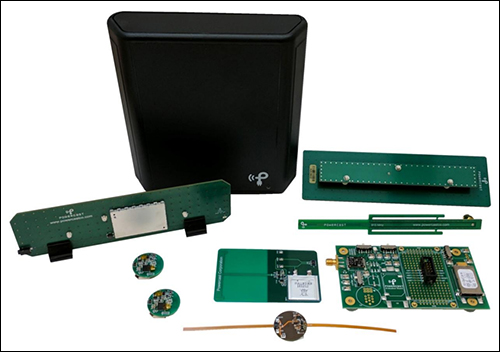Powercast is selling a development kit that contains the hardware and apps consumer goods manufacturers need to incorporate wireless power-harvesting technology into their wireless products. The kit is intended to enable companies to test wireless charging on their own power-using mobile devices. The long-term aim, according to Powercast, is for businesses to begin building recharging functionality into their products. Devices that could benefit from the technology include remote controls, gaming devices, ear buds, hearing aids, wireless sensors, and wearables, as well as active radio frequency identification (RFID) tags, or Near Field Communication (NFC) and Bluetooth Low Energy (BLE) devices.
Powercast, a Pittsburg-based wireless power company, was launched 14 years ago to build solutions that charge batteries via RF signals. Traditionally, the firm has focused on products that harvest RF signals for the industrial or commercial market. It makes, for instance, a solution for powering devices used by heating, ventilation and air conditioning (HVAC) products (see Powercast Debuts Energy-Harvesting Wireless Sensor System). The company launched its solution for the commercial sector with a development kit in 2010.
The Powercaster can transmit the power harvested by devices up to 80 feet and was originally designed for industrial and commercial use. The technology can use RF transmissions at 10 MHz to 6 GHz and a proprietary air-interface protocol to power devices using built-in Powerharvester chips. The FCC-approved transmitter, however, sends RF power at 915 MHz. The chips convert the RF energy to DC, thereby recharging a device’s battery.
Now, Powercast has added consumer goods to its portfolio of applications. The company has noted the growing demand for wireless charging in the consumer market, says Charlie Greene, Powercast’s chief operating and technical officer. “The number of devices that require charging is growing,” he explains, and that growth was recently illustrated when Apple eliminated the wire jack for earbuds, which requires that users now recharge the earbuds as well as their phone. “That’s just one more thing that had to be plugged in” for recharging, he adds.
The P1110-EVAL-01 development kit includes an FCC-approved Powercaster transmitter, battery-recharging boards (in applicable shapes such as for wristbands or smart cards), a Powerharvester evaluation board and receiving antennas, BLE radio boards, and the first version of its new PowerSpot transmitter. PowerSpot, the next generation of the Powercast transmitter, will measure approximately one-fourth the size of its industrial-focused counterpart, the company reports; it measures about 7 inches in length by 2 inches in height by 0.75 inch in depth, and is designed for consumer-facing applications.
The system could be used to power wearable sensors or devices such as heated jackets or illuminated safety vests. It could also be employed by active RFID-enabled devices, such as smart wristbands worn by passengers on cruise lines or attendees at theme parks, so that they could be reused.
The PowerSpot could be a standalone device or be built into another product, such as a clock radio. This would enable consumers to simply place all items for recharging within the vicinity of that charger in their home. The system’s exchange of information takes place only between the PowerSpot and the PowerHarvesters. It comes with a selectable option to charge automatically when a device is within range, or only when initiated by the user.
The kit also comes with iOS- and Android-based apps to monitor the recharging current of the batteries in the kit. Developers will first download the app, then plug the BLE and PowerHarvester boards into their own devices, and begin experimenting with the PowerSpot or Powercast transmitters also provided in the kit. They can then test the amount of energy they can achieve with their device, as well as how the system could be used.
The goal, Greene says, is to enable the makers of smart watches, smart cards, ear buds and other devices to build wireless power-harvesting functionality into their products. The RF range for consumer products is targeted at about 10 feet, he adds, and the amount of charging would vary based on the type of device and how much it is used. Charging at closer range could provide faster recharges for power-hungry, heavily used devices, such as gaming remotes or computer mice.
The BLE radio boards provide another alternative for charging. The system can employ Bluetooth Low Energy transmission to enable developers to build a system that transmits measured charge current and battery voltage via BLE. The RF charging frequencies were designed as proprietary air-interface protocols that would not interfere with the commonly used 2.4 GHz or 5.8 GHz frequencies, Greene says.
“Purely as a consumer, I’m hoping companies integrate this technology to reduce the amount of things we have to plug in,” Greene states. While the industrial version of the Powercast system was focused on reducing labor for companies, the consumer version is simply about convenience. “My goal is to make things easier,” he says.
Companies have been buying the kits since they were released this month, while Powercast has been in conversations with other companies for the past six months regarding how the technology could be used. The kit is priced at $1,250, and companies can purchase it via Mouser, Arrow or Future Electronics.



